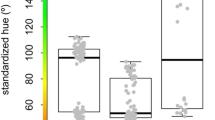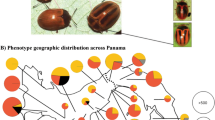Summary
Polymorphism in adult colour pattern ofNezara viridula is determined on the genetic basis. The basic colour patterns of adult are classified into four types, i. e. G, O, R and F. No appreciable differences between these types were observed in respect to various physiological traits of nymphs and adults, except that type G seems to be superior in reproductive ability but to be inferior in ability of surviving winters at least to types R and F.
Inter-generation changes in percentage frequency of G type were examined from 1959 to 1967 covering more than 30 generations. Percentage frequencies of G types prior to the severe winter of 1962–3 fluctuated greatly around a mean of 87.9%, while they did to a lesser extent than before with a mean of 85.0% after the winter. Unexpected high percentages of G type were recorded frequently in summer generations, viz. 1st and 2nd. On the other hand, the relative frequencies of G and O types decreased after hibernation in contrast to the increases in those of F and R. This sort of changes in genetic composition related to the winter of 1962–3 was observed in several populations segregated from each other.
This seasonal alternation of selective activity in the environments is considered to be responsible for retention of the polymorphism. Alternative possible causes, i. e. difference in habitat preference, non-random mating and selective predation by predators among polymorphs, may safely be rejected as irrelevant to the mechanism in maintaining polymorphism.
The polymorphism of this insect seems to be in a transient state rather than balanced one contributing little to population regulation, but the persistence ofN. viridula in the periphery range may be assisted by retention of the polymorphism.
Similar content being viewed by others
References
Birch, L. C. (1955) Selection inDrosophila pseudoobscura in relation to crowding.Evolution 9: 389–399.
Birch, L. C. (1960) The genetic factor in population ecology.Amer. Nat. 94: 5–24.
Cain, A. J. andP. M. Sheppard (1954) The theory of adaptive polymorphism.Amer. Nat. 88: 321–326.
Cain, A. J. andP. M. Sheppard (1954) Natural selection in Cepaea.Genetics 39: 89–116.
Chitty, D. (1958) Self-regulation of numbers through changes in viability.Cold Spring Harbour Symp. Quant. Biol. 22: 277–280.
De Ruiter, L. (1952) Some experiments on the camouflage of stick caterpillars.Behaviour 4: 222–232.
Dobzhansky, Th. (1943) Genetics of natural populations, IX. Temporal changes in the composition of populations ofDrosophila pseudoobscura.Genetics 28: 162–186.
Dubinin, N. P. andG. G. Tiniakov (1945) Seasonal cycles and the concentration of inversions in populations ofDrosophila funebris.Amer. Nat. 79: 570–572.
Farish, D. J. andG. G. E. Scudder (1967) The polymorphism inPhilaenus spumarius (L.) (Hemiptera: Cercopidae) in British Columbia.J. Ent. Soc. Brit. Columbia 64: 45–50.
Ford, E. B. (1940)Polymorphism and taxonomy in The New Systematics. 493–513, Oxford.
Ford, E. B. (1961) The theory of genetic polymorphism. pp. 9–19. in “Insect Polymorphism” ed. byKennedy, J. S. Sym. No. 1. Roy. Ent. Soc. London.
Franz, J. (1950) Über die genetischen Grundlagen des Zusammenbruchs einer Massenvermehrung inneren Ursachen.Z. angew. Ent. 31: 228–260.
Gershenson, S. (1945) Evolutionary studies on the distribution and dynamics of melanism in the hamster (Cricetus cricetus L.). II. Seasonal and annual changes in the frequency of black hamsters.Genetics 30: 233–251.
Hasegawa, H. (1954) Notes onNezara viridula (Linne) and its allied green stink-bug in Japan.Bull. Nat. Inst. Agr. Sci. (Japan). Ser. C 4: 215–228 (In Japanese with English summary).
Kariya, H. (1961) Effect of temperature on the development and the mortality of the southern green stink bug,Nezara viridula and the oriental green stink bug,N. antennata.Jap. J. Appl. Ent. Zool. 5: 191–196.
Kettlewell, H. B. D. (1961) The phenomenon of industrial melanism in the Lepidoptera.Ann. Rev. Ent. 6: 245–262.
Kiritani K. andJ. Yukawa (1963) A note on the polymorphism ofN. viridula andN. antennata.Rostria No. 5. 19–21 (In Japanese).
Kiritani, K., Hokyo, N. andJ. Yukawa (1963) Co-existence of the two related stink bugsNezera viridula andN. antennata under natural conditions.Res. Popul. Ecol. 5: 11–22.
Kiritani, K. (1964) The effect of colony size upon the survival of larvae in the southern green stink bug,Nezara viridula.Jap. J. Appl. Ent. Zool. 8: 45–54.
Kiritani, K. (1964) Natural control of populations of the southern green stink bug,Nezara viridula.Res. Popul. Ecol. 6: 88–98.
Kiritani, K. (1965) The natural regulation of the population of the southern green stink bug,Nezara viridula. Proc. XII. Int. Congr. Ent. London, 1964 (1965): 375.
Kiritani, K., (1965) Factors determining the distribution of the two related stink bugs,Nezara viridula L. andN. antennata Scott.Proc. XII. Int. Congr. Ent. London, 1964 (1965): 423.
Kiritani, K. (in press) Studies on the population dynamics of the southern green stink bug.Min Agric Forest. Japan (In Japanese).
Kiritani, K., Hokyo, N., Kimura, K. andF. Nakasuji (1965) Imaginal dispersal of the southern green stink bug in relation to feeding and oviposition.Jap. J. Appl. Ent. Zool. 9: 291–297.
Kiritani, K., Hokyo, N. andK. Kimura (1966) Factors affecting the winter mortality in the southern green stink bug,Nezara viridula L.Ann. Soc. ent. France 2: 199–207.
Kiritani, K. andK. Kimura (1967) Effects of parental age on the life cycle of the green stink bug,Nezara viridula L. (Heteroptera: Pentatomidae).Appl. Ent. Zool. 2: 69–78.
Kiritani, K. (1968) Notes on biology of pentatomids and their control.Noyaku 14: 1–9 (In Japanese).
Kiritani, K. andT. Sasaba (1969) The differences in bio- and ecological characteristics between neighbouring populations in the southern green stink bug,Nezara viridula L.Jap. J. Ecol. 19: 177–184.
Komai, T. andY. Hosino (1951) Contributions to the evolutionary genetics of the lady-beetle,Harmonia, II. Microgeographic variations.Genetics 35: 589–601.
Oho, N. andK. Kiritani (1960) Biology and control ofNezara viridula.Shokubutsu Bôeki 14: 237–241 (In Japanese).
Pimentel, D. (1961) Animal population regulation by the genetic feed-back mechnism.Amer. Nat. 95: 65–79.
Sameshima, T. (1960) Infestation and damage caused by the southern green stink bug.Shokubutsu Bôeki 14: 242–246 (In Japanese).
Timofeeff-Ressovsky, N. W. (1940) Zur Analyse des Polymorphismus beiAdalia bipunctata.Biol. Zbl. 60: 130–137.
Sheppard, P. M. (1952) A note on the non-random mating in the mothPanaxia dominula (L.),Heredity 6: 239–241.
Uvarov, B. P. (1961) Quantity and quality in insect populations.Proc, Roy. Ent. Soc. 25: 49–59.
Wellington, W. G. (1960) Qualitative changes in natural populations during changes in abundance.Can. J. Zool. 38: 289–314.
Whittaker, J. B. (1968) Polymorphism ofPhilaenus spumarius (L.) (Homoptera, Cercopidae) in England.J. Anim. Ecol. 37: 99–111.
Wilbert, H. (1963) Können Insektenpopulationen durch Selectionprozesse reguliert werden.Z. ang. Ent. 52: 185–204.
Williamson, W. H. (1958) Selection, controlling factors and polymorphism.Amer. Nat. 92: 329–335.
Wilson, F. (1965) Biological control and the genetics of colonizing species.The Genetics of Colonizing Species. Academic Press, New York, 307–329.
Yukawa, J. andK. Kiritani (1965) Polymorphism in the southern green stink bug.Pacific Insects 7: 744–747.
Author information
Authors and Affiliations
Rights and permissions
About this article
Cite this article
Kiritani, K. Studies on the adult polymorphism in the southern green stink bug,Nezara viridula (hemiptera: Pentatomidae). Res Popul Ecol 12, 19–34 (1970). https://doi.org/10.1007/BF02511079
Issue Date:
DOI: https://doi.org/10.1007/BF02511079




